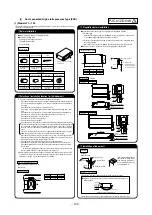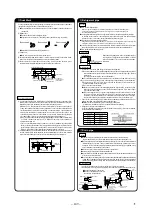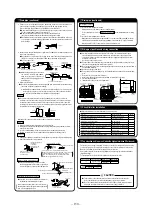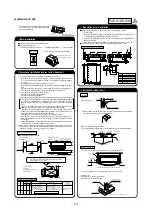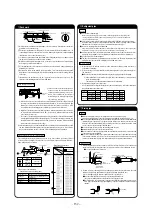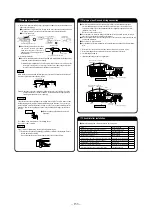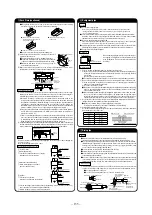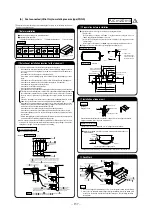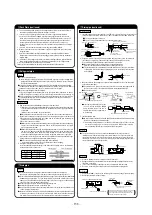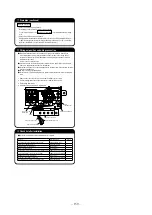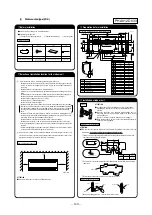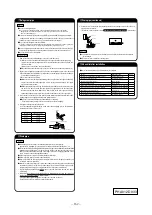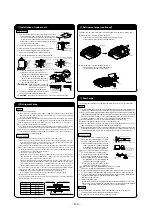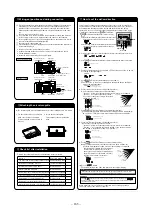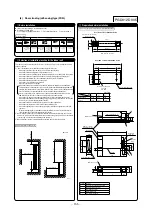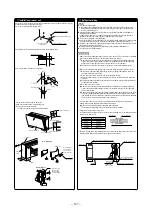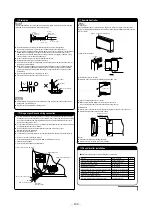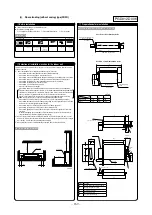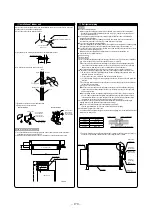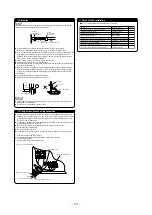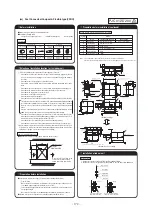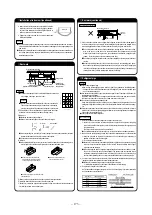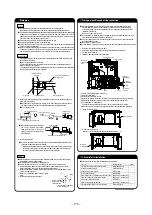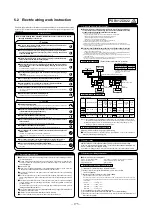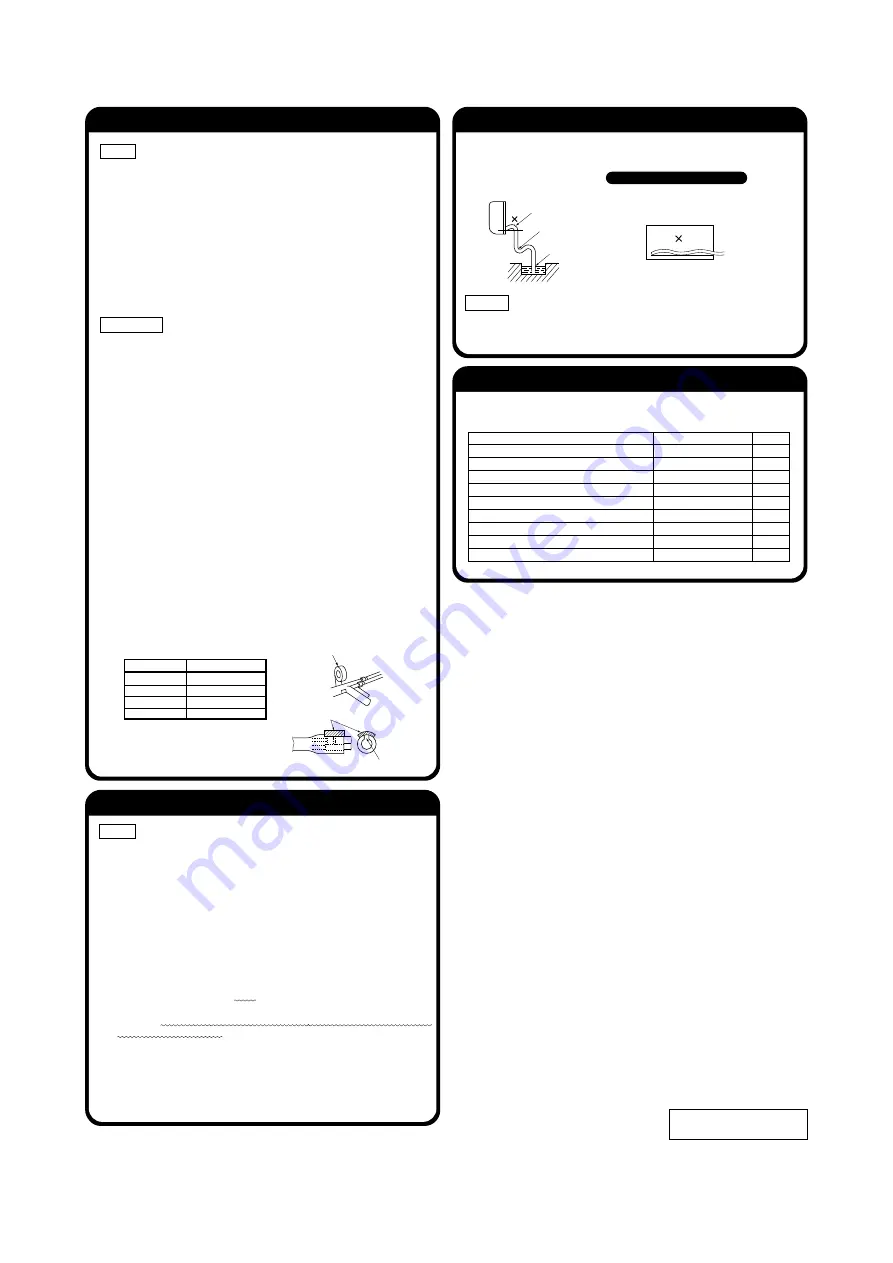
-
162
-
PHA012D033
⑥
Shaping of pipes and drain hoses
⑦
Refrigerant pipe
⑧
Drain pipe
1. A general-purpose hard PVC pipe VP-16 can be connected to the drain hose tip as a part of
drain piping.
2. Drain piping must be given a descending grade so that drain water may flow smoothly and it
must not have any trap or bump within the system.
(The pipe can be routed through the left, right, rear or bottom of the unit)
Hard PVC pipes (VP-16) laid indoors must be kept warm.
Pipe diameter
Tightening torque N·m
φ
6.35
φ
9.52
φ
12.7
φ
15.88
14 to 18
34 to 42
49 to 61
68 to 82
⑤
Wiring-out position and wiring connection
④
Installation of indoor unit (continued)
CASE 1 : MODEL 22 56, CASE 2 : MODEL 71
1. Open the intake panel. (Pull the lower part of the intake panel holding both ends, disengage the
latches and then lift it until you feel some drag. The intake panel will stay open at an angle of
about 60
°
)
2. Remove the screw and detach the cover.
3. Connect the remote control line to the upper one of the two terminal blocks provided in the
control box.
4. Connect the power cable, grounding line and signal line to the lower terminal block.
5. Attach the cover and fasten the screw.
6. Close the intake panel.
(Note)
・
Connect each line to terminal block according to number on label of terminal block.
⑨
Check list after installation
Position it so that the slit area faces upward.
Use an attached insulation pad for heat insulation.
Vinyl tape
●
Panel removal steps
1. Remove the cap.(CASE1.only)
2. Remove the fixing screw A and detach the unit
bottom guide.(CASE1.only)
3. Remove the fixing screw B.
4. Pull the lower part of the front panel off the unit
toward you, and then push it up to detach its
upper part from the unit.
(Disengage three hooks located on the top part)
●
Panel attachment steps
1. Always remove the air filter beforehand.
2. Place the front panel over the unit.
3. Engage it onto the unit by pressing the areas
marked with in the drawing from the front.
4. Fasten the fixing screw B.
5. Set the air filter.
6. Attach the unit bottom guide and fasten the
fixing screw A.(CASE1.only)
7. Attach the cap.
(Plug it in securely until the end so that it won't
come off easily) (CASE1.only)
Fig.1(CASE1)
Push
Hook
Fixing screw B
Fig.2(CASE2)
Intake panel
Screw
Cover
REFERENCE FOR CASE 1
Pipe routed through the left
Pipe routed through the right
Steps to change drain hose connection positions
1. Remove the drain hose.
Pipe routed through the left rear
Pipe routed through the left
Pipe routed through the right rear
Pipe routed through the right
(Points for attention when the pipe is routed through the left or the rear of the unit.)
View from the top
Pipe space
Gutter
Wall
The pipe can be routed through the rear, left,
left rear, right or bottom of the unit.
Right
Rear
Bottom
Left bottom
Left rear
Left
This air conditioner is designed to collect
dew formed on its back in the drain pan for
discharging, so do not lay power cables,
etc. in any part above the gutter.
2. Remove the drain cap and heat insulating material.
3. Plug in the drain cap and heat insulating material.
●
Plug the drain cap removed in the step 2
securely into the hole with a hexagonal wrench
or the like.
Note:
●
Remove it either manually or with pliers.
●
Turn the drain hose and pull it out.
4. Connect the drain hose.
●
Insert the drain hose securely by turning it.
Note:
(When it is routed through the rear)
○
Shaping of pipes
○
Tape wrapping
Pipe
Drain hose
Make sure that wires are connected
securely onto the terminal block,
before you dress them with a tape
after shaping the pipe.
●
Wrap a tape for the length that corresponds to a penetration
through the wall.
●
The connecting wires must be wrapped together with the pipe.
●
Hold the root of the pipe
to change its direction,
straighten it and then
shape it.
Terminal block for
Remote Controller
Terminal block
Cord clamp
Power cable, Earth
Signal line
Caution
●
Use the new refrigerant pipe.
When re-using the existing pipe system for R22 or R407C, pay attention to the following items.
・
Change the flare nuts with the attached ones (JIS category 2), and reprocess the flare parts.
・
Do not use thin-walled pipes.
●
Use phosphorus deoxidized copper alloy seamless pipe (C1220T specified in JIS H3300) for refrigeration pipe installation.
In addition, make sure there is no damage both inside and outside of the pipe, and no harmful
substances such as sulfur, oxide, dust or a contaminant stuck on the pipes.
●
Do not use any refrigerant other than R410A.
Using other refrigerant except R410A (R22 etc.) may degrade inside refrigeration oil. And air getting into
refrigeration circuit may cause over-pressure and resultant it may result in bursting, etc.
●
Store the copper pipes indoors and seal the both end of them until they are brazed in order to avoid any dust, dirt or
water getting into pipe. Otherwise it will cause degradation of refrigeration oil and compressor breakdown, etc.
●
Use special tools for R410 refrigerant.
Work procedure
1. Remove the flare nut and blind flanges on the pipe of the indoor unit.
※
Make sure to loosen the flare nut with holding the nut on pipe side with a spanner and giving
torque to the nut with another spanner in order to avoid unexpected stress to the copper pipe, and
then remove them.
(Gas may come out at this time, but it is not abnormal.)
●
Pay attention whether the flare nut pops out. (as the indoor unit is sometimes pressured.)
2. Make a flare on liquid pipe and gas pipe, and connect the refrigeration pipes on the indoor unit.
※
Bend the pipe with as big radius as possible and do not bend the pipe repeatedly. In addition,
do not twist and crush the pipes.
※
Do a flare connection as follows:
●
Make sure to loosen the flare nut with holding the nut on pipe side with a spanner and giving
torque to the nut with another spanner in order to avoid unexpected stress to the copper
pipe, and then remove them.
●
When fastening the flare nut, align the refrigeration pipe with the center of flare nut, screw
the nut for 3-4 times by hand and then tighten it by spanner with the specified torque
mentioned in the table below. Make sure to hold the pipe on the indoor unit securely by a
spanner when tightening the nut in order to avoid unexpected stress on the copper pipe.
3. Cover the flare connection part of the indoor unit with attached insulation material after a gas
leakage inspection, and tighten both ends with attached straps.
●
Make sure to insulate both gas pipes and liquid pipes completely.
※
Incomplete insulation may cause dew condensation or water dropping..
4. Refrigerant is charged in the outdoor unit.
As for the additional refrigerant charge for the indoor unit and piping, refer to the installation
manual attached to the outdoor unit.
Caution
●
Install the drain pipe according to the installation manual in order to drain properly.
Imperfection in draining may cause flood indoors and wetting the household goods
,
etc.
●
Do not put the drain pipe directly into the ditch where toxic gas such as sulfur, the other harmful and
inflammable gas is generated. Toxic gas would flow into the room and it would cause serious
damage to user’s health and safety (some poisoning or deficiency of oxygen). In addition, it may
cause corrosion of heat exchanger and bad smell.
●
Connect the pipe securely to avoid water leakage from the joint.
●
Insulate the pipe properly to avoid condensation drop.
●
Check if the water can flow out properly from both the drain outlet on the indoor unit and the end
of the drain pipe after installation.
●
Make sure to make descending slope of greater than 1/100 and do not make up-down bend and/or trap in
the midway. In addition, do not put air vent on the drain pipe. Check if water is drained out properly from
the pipe during commissioning. Also, keep sufficient space for inspection and maintenance.
3. Pour water into the drain pan placed underneath the heat exchanger to make sure that it is
properly drained outdoors.
No bumps
No traps
Not to be in water
●
Check the following items after all installation work completed.
Check if;
Expected trouble
Check
The indoor and outdoor units are fixed securely?
Falling, vibration, noise
Inspection for leakage is done?
Insufficient capacity
Insulation work is properly done?
Water leakage
Water is drained properly?
Water leakage
Supply voltage is same as mentioned in the model name plate?
PCB burnt out, not working at all
There is mis-wiring or mis-connection of piping?
PCB burnt out, not working at all
Earth wiring is connected properly?
Electric shock
Cable size comply with specified size?
PCB burnt out, not working at all
Any obstacle blocks airflow on air inlet and outlet?
Insufficient capacity
⑧
Drain pipe (continued)
●
Electrical installation work must be performed according to the installation manual by an
electrical installation service provider qualified by a power provider of the country, and be
executed according to the technical standards and other regulations applicable to electrical
installation in the country.
Be sure to use an exclusive circuit.
●
Use specified cord, fasten the wiring to the terminal securely, and hold the cord securely in
order not to apply unexpected stress on the terminal.
●
Do not put both power source line and signal line on the same route. It may cause miscom-
munication and malfunction.
●
Be sure to do D type earth work.
●
For the details of electrical wiring work, see attached instruction manual for electrical wiring
work.
Drain test
●
After installation of drain pipe, make sure that drain system work in good condition and no water leakage from
joint and drain pan.
●
Do drain test even if installation of heating season.
Unit installation
Wall
Indoor unit base
bottom latch
Installation steps
Indoor unit
Lid (Right)
Mounting plate
Latch (2 places)
Mounting
plate
①
Hang the upper part of the
indoor unit onto the mounting
plate.
②
Push the lower part of the
indoor unit lightly against the
wall for one-touch installation.
(For removal of the front panel, refer to
⑤
Wiring-out position and wiring connection
in this manual.
• To remove the unit from the mounting plate, first remove the right and left lids and then
disengage the indoor unit base bottom latches.
Pay attention that a drain hose not properly
plugged in can cause a water leak.
Pay attention that a drain cap not properly
plugged in can cause a water leak.
PHA012D033
Summary of Contents for 112KXE6
Page 105: ... 101 Model FDC335KXE6 A PCB003Z035 shows local wining ...
Page 134: ... 130 PJF012D003 ...
Page 135: ... 131 ...
Page 139: ... 135 PJA012D751 b ...
Page 140: ... 136 ...
Page 206: ... 202 2 model type DIS model type HEAD ...
Page 207: ... 203 2 2 ...
Page 208: ... 204 2 2 2 2 2 ...

